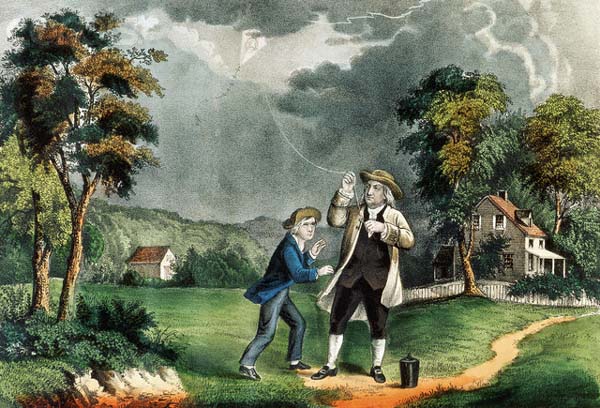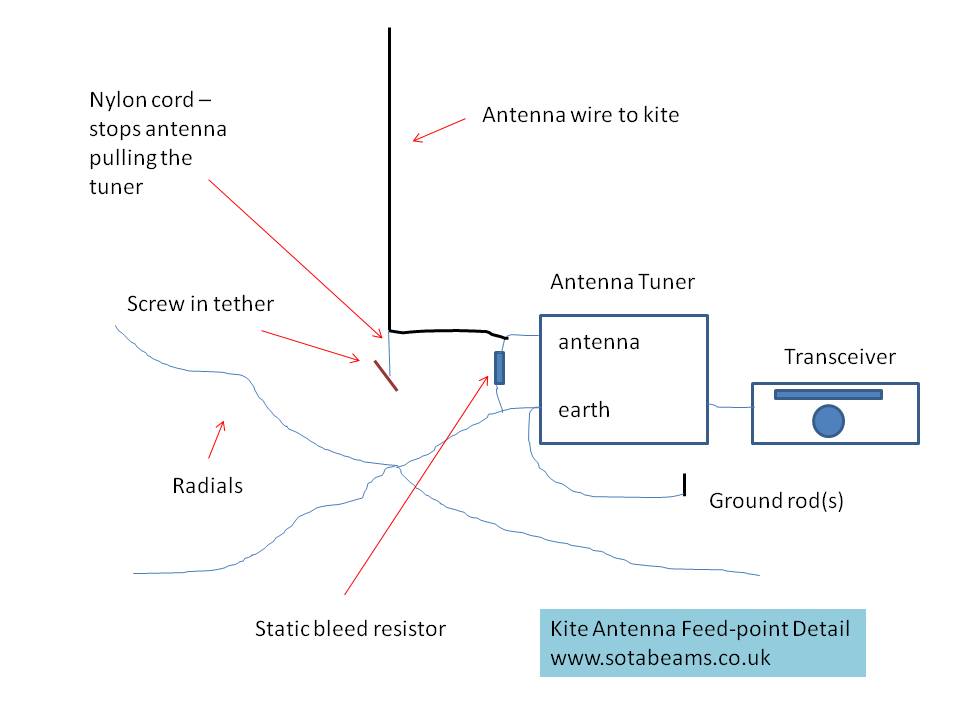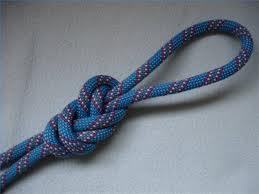This page is a compilation of a series of posts that I wrote on the SOTAbeams Facebook page about kite flying. It picks up on some of the things that I have learned after nearly 40 years of using kite-borne antennas.
73 Richard G3CWI
Safety First:
In many areas there are restrictions on kite flying. Check your local and national regulations first.
Kite antennas must never be used if there is any risk of lightning.

Ensure that your kite system will fail safely. Imagine what would happen if a kite towing a long wire came into contact with power lines.
Choice of a kite for antenna lifting: Size matters. I recommend a kite with an area of between 0.8 and 1.2m2. Any bigger and you will find yourself fighting to control it. Any smaller and it will not do the job. Look for a kite with a good range of operating windspeeds; ours is 5-18MPH. This allows you to use the kite in a wide range of conditions. Rigid kite structures such as box kites used to be popular but newer designs work much better. You are aiming for a "fly and forget" kite. The newer semi rigid kites have another advantage -if the string breaks they lose lift and fall quickly. Rigid kites fly away!
Attaching antennas to a kite: there are a few things to think about here. For a vertical hung from the kite line you will get best stability if the antenna is well down the line from the kite (at least 10m). You will need a loop to attach the antenna system to the line. Use a knot that will not weaken the line. I will cover knots in another post. Dont tie the wire for the vertical directly to the kite line. Use a length of elastic shock cord (5m is good) - the vertical wire is attached to the lower end of the shock cord. This will reduce the tension in the wire and again will aid stability. Of course using a long wire as the kite line is possible, but this can result in a rather unstable antenna. Much better is to use the kite to support the centre of an end fed 3/8 wave. Again the techniques suggested for the vertical are used to give a stable installation.


Kite Antenna systems: designed to fail (safely). Things go wrong when flying kite antennas; it's a fact. When something goes wrong, you want to be in control of how it fails. It's a good idea to build some weak points into the system. Ideally the point of failure should be at the kite. If the kite seperates from the line it will fall fairly fast and with luck you will get it back. I once lost one of mine in a wheat field and got it back three months later when the farmer - who knew it was there - spotted it from his combined harvester.
The worst scenario is that you are using the wire as the kite line and it breaks at the ground level. The weight and drag of the wire will keep the kite flying - for miles sometimes. Also, the wire may well get caught in power lines etc - a real hazard. This is the main reason why I prefer to fly verticals dropped off the kite line. In this case I use a thin line at the top of the vertical. This does not need to be very strong as it only supports the antenna weight - not the pull of the kite.
Kites - static discharge: having a static leakage system on your kite antenna is an essential requirement. This needs to present a high impedance to RF and a relatively low impedance to the static charge. The RF impedance of the leakage system needs to be at least ten times the antenna impedance at the lower end. If you work on an end impedance of 10k Ohms (for an end fed wire) you can see that the impedance needs to be high. RF chokes are possible as are parallel tuned circuits (in some cases). However, best perfiormance across all bands is likely to be achieved with a non-inductive resistor of a value of at least 100k Ohms. I would go for 470k or 1 Meg. Use one rated at 2 Watts or so. Across it I would make a spark gap - but if you are seeing sparks you are in trouble!
Kites and Static: Flying kites in thunderstorms is clearly dangerous but even in normal weather huge static charges can build up on kite-borne antennas. I recommend connecting an RF choke from the antenna to a ground stake. Some configurations of antenna tuning unit will have a connection between the antenna and earth.
Getting a good ground connection can be tricky. I tend to use several tent pegs all bonded together. On rocky summits you may well struggle to get an earth. A radial laid on the ground will be better than nothing. Static rain can be a real problem with kite aerials. Frankly if it is a problem, you would be safest to abandon the activation. Static rain can make all sorts of odd sounds in your receiver. If the band is just covered in noise and the S meter is hanging at S9+, it's probably static rain. Oh and it does not have to be raining either. Even microscopic particles get charged.
Go fly your kite: all that running up and down and jiggling kite strings is for amateurs. This is how to fly your kite. Before doing this you will need to have designed your antenna system so that you know exactly how much kite string you need to fly it. I will cover this in another post.
In addition to your kite you will need a strong anchor point for the end of the string. Remember, you want to play radio - not fiddle with kites. A dog anchor screw is ideal for this.

Pick one suitable for a big dog - not some puny handbag dog. Fasten the screw in the ground and attach the end of the string to it. Use a good strong knot! Next find which way the wind is blowing to (not from). Walk down wind, paying out the string as you go - all of it not just a bit. Attach the kite to the end. Now facing into the wind (towards the anchor point) hold the kite out and walk back to tighten up the string. Holding the kite open, upright and standing behind it just wait for a nice gust of wind to catch the kite. Then release it and watch it soar into the air. Easy. The reason this works so well is that the kite exits the turbulent airflow close to the ground and enters the higher more stable airflow very quickly.
At that point you realise that you forgot to attach the antenna but hey, launching is now so easy you can do it again :)
The smart activator pulls a carabiner out of his/her pocket at this stage and clips it onto the kite line.
Kite Physics: This NASA applet allows you to compare different types of kites.
http://www.grc.nasa.gov/WWW/k-12/airplane/kiteprog.html
Kite Sites:
- I met Bob G4VGO out in the Far East once. He's quite a character! His kite flying exploits and insights are worth a look.
- Experiences with kite-supported wire antennas by VK3YE
- Jack VK3WWW has provided some good videos about his kite set-up.
- N5DUX's Kite Antenna page
Kite Items from SOTAbeams:
Questions from readers
Q: what is the best way to attach the antenna to the kite line ?
A: I would tend to use a fishing swivel at the point where the antenna systen is attached to the kite line.

Q: what is the best knot to attach the shock cord to the kite line and the antenna ?
A: the best knot will depend to some extent on the type of wire that you use. I would tend to tie a figure of eight knot at the end of the antenna to form a loop.

Q:what is the best knot to attach the kite to the kite line ?
A: a Bowline.
Q: what is the best knot to attach the kite line to the dog anchor screw ?
A: a Bowline.


